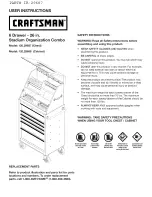
167
Technology Background
Pegasus3 Product Manual
A RAID 5 on Pegasus R4 consists of three or four physical drives. A RAID 5 on Pegasus R6 consists of
three to six physical drives.
Recommended Applications for RAID 5:
•
File and Application servers
•
WWW, E-mail, and News servers
•
Intranet servers
RAID 6 – Block and Double Parity Stripe
RAID level 6 stores dual parity data is rotated across the physical drives along with the block data. A
RAID 6 logical drive can continue to accept I/O requests when any two physical drives fail.
Figure 5. RAID 6 stripes all drives with data and dual parity
Hence, a RAID 6 logical drive with (7) 100 GB physical drives has a capacity of 500 GB. A RAID 6
logical drive with (4) 100 GB physical drives has a capacity of 200 GB.
RAID 6 becomes more capacity efficient in terms of physical drives as the number of physical drives
increases.
RAID 6 provides double fault tolerance. Your logical drive remains available when up to two physical
drives fail.
RAID 6 is generally considered to be the safest RAID level. A RAID 6 on Pegasus R4 consists of four
physical drives.
Advantages
Disadvantages
•
High Read data transaction rate
•
Medium Write data transaction rate
•
Good aggregate transfer rate
•
Most versatile RAID level
•
Disk failure has a medium impact on
throughput
Double Distributed (Wide-space Q+Q) Parity
Physical Drives
Data
Blocks
Summary of Contents for Pegasus3 R4
Page 4: ...iv Promise Technology Pegasus3 R4 R6 R8 VCCI KCC FCC ...
Page 5: ...v About this guide Pegasus3 Product Manual WARNING WARNING WARNING WARNING ...
Page 80: ...67 Managing the Pegasus3 Pegasus3 Product Manual Controller Settings ...
Page 207: ...194 Promise Technology Pegasus3 R4 R6 R8 View NVRAM Events ...
















































